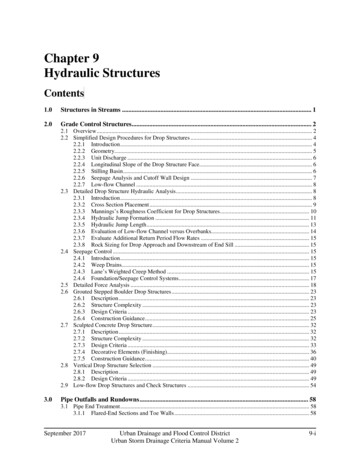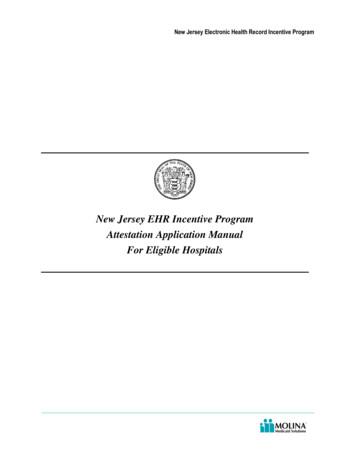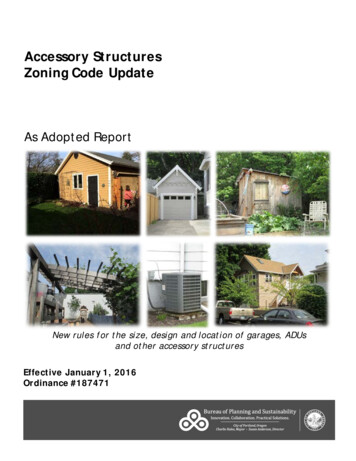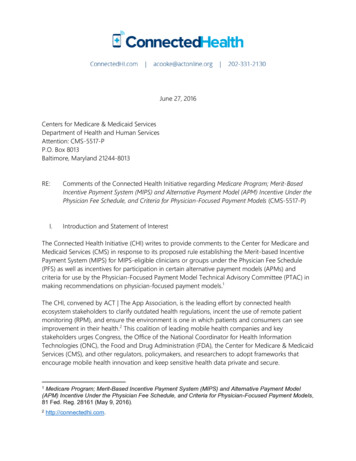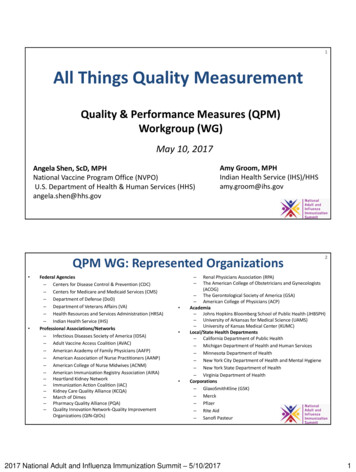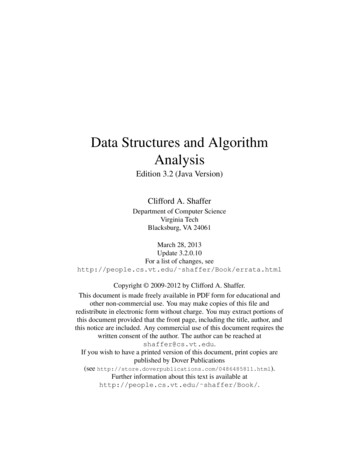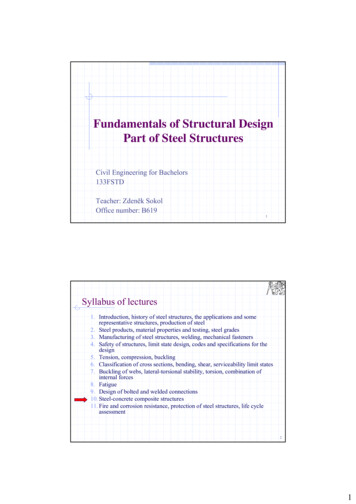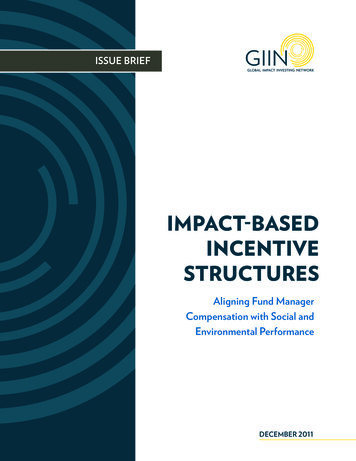
Transcription
ISSUE BRIEFImpact-Based Incentive StructuresISSUE BRIEFTur? Debis asi omni alistemostisquiatis aut re ea voluptur?Occae pro to ml exerrovitearuptae que omnihit que volorase volorro tem velent.IMPACT-BASEDINCENTIVESTRUCTURESAligning Fund ManagerCompensation with Social andEnvironmental PerformanceDECEMBER 2011www.thegiin.org1
ISSUE BRIEFImpact-Based Incentive StructuresIn traditional private equity funds, the compensation for general partners(GP)1 is driven by incentives linked to the funds’ fundamental objective –the maximization of profits for their investors. Many impact investmentfunds have adopted this compensation structure, in which GPs take a shareof the profits realized from their portfolios. However, managers of thesefunds must balance a more complex set of objectives: achieving socialand/or environmental impact in addition to generating financial returns.Given this complexity, how can investors ensure that impact objectives areappropriately weighted in investment decisions?This issue brief draws fromearly examples of impact-basedincentive structures to present aframework to guide prioritizationin the design of such approaches.Some impact investors are attempting to address this challenge by tying aportion of GP compensation to social and environmental performance. Animpact-based incentive structure raises the GP’s financial stake in the nonfinancial performance of their funds.As the impact investing industry develops, the Global Impact Investing Network (GIIN)is observing growing interest in impact-based incentive structures—both how they canbe designed and how they work in practice. The concept of incorporating non-financialperformance in GP compensation is relatively novel. This issue brief draws from earlyexamples to explore key considerations in putting together such structures and presents aframework to guide prioritization in their design.In exploring this topic, the GIIN hopes to spark further dialogue on opportunities andchallenges around impact-based incentive structures. The GIIN does not advocate theuse of such structures, nor does it endorse a specific approach. As the industry evolves, itmust remain accountable to social and environmental goals. For impact investment funds,these incentive structures may complement rigorous measurement and assessment of socialand environmental performance to increase accountability and transparency around theachievement of their objectives.1In the context of private equity funds, which are commonly structured in the legal form of a limited partnership, a generalpartner, or GP, has unlimited liability for debts and obligations in the partnership and holds management responsibilities.A GP is typically the firm managing the fund. A limited partner, or LP, is a partner that has limited liability for debts andobligations according to the share of ownership. LPs are individual or institutional investors that contribute capital to privateequity funds.www.thegiin.org1
ISSUE BRIEFImpact-Based Incentive StructuresResearch MethodologyThis issue brief is based on research conducted through more than a dozen interviewswith members of the GIIN Investors’ Council2 and other leading impact investors who areknowledgeable about the topic.3 Several of those interviewed have implemented impact-basedincentive structures as GPs or have participated as LPs in funds with such practices. This researchidentified several funds with management compensation structures that incorporate socialand environmental performance, and three distinct approaches are profiled and referencedthroughout this paper. The three entities whose impact-based incentive structures are highlightedare Aureos Capital’s Africa Health Fund (Aureos), Core Innovation Capital (Core), and UBS.Key Considerations for DesigningImpact-Based Incentive StructuresEarly examples suggest that there are a variety of ways to design impact-based incentivestructures for GPs, and that each approach prioritizes specific financial and impact objectives.The funds featured in this discussion have the traditional private equity or fund of fundscompensation model as the basis for their impact-based incentive structures. That is, the GP ispaid an annual salary, an annual bonus, and a carry, or a set percentage of the financial returnsthat result from an investment’s liquidation. Those considering impact-based incentive structuresin the context of these two types of funds can use the following key questions to broadlydetermine a compensation design that aligns with their financial and impact objectives: Should incentives address the portfolio’s short-term or long-term impact performance,or both? Should incentives penalize and/or reward GPs for the extent to which impact targetsare met? What is the appropriate amount of compensation linked directly to social and environmentalperformance? What should be done with any monetary proceeds not distributed to GPs dueto inability to meet impact targets? How and by whom are social and environmental performance metrics and targets defined? How can social and environmental performance be effectively monitored?The profiles on pages 3-5 outline the impact-based incentive structures employed byAureos Capital’s Africa Health Fund, Core Innovation Capital, and UBS. The discussionthat follows explores the key considerations highlighted above to help guide thinking aboutthe design of impact-based incentive structures. These three examples are referencedthroughout the discussion to illustrate ways these considerations can be addressed.23The Investors’ Council is the membership program of the GIIN. It serves as a platform for leading, active impact investorsto share experiences, learn about emerging sectors, explore opportunities for collaboration, and contribute to industrydevelopment. Members of the Investors’ Council include family offices, diversified financial institutions, fund managers,specialized banks, institutional investors, foundations, and development finance institutions.For a complete list of individuals who contributed their perspectives to this issue brief, see page 11.www.thegiin.org2
Impact-Based Incentive StructuresISSUE BRIEFAureos Capital’s Africa Health FundFUND OVERVIEWBACKGROUNDAureos Capital’s Africa Health Fund investsacross Africa in healthcare enterprises servingpeople who live at the base of the socio-economicpyramid (BoP), which the fund defines as thosewho earn an average annual household incomeof less than 3,000 in purchasing power parity*(PPP) terms. The Africa Health Fund applies arigorous environmental, social, and governance(ESG) screen, along with additional impactconsiderations, to investments. The fund is oneof 17 funds managed by Aureos Capital, a US 1.3billion specialist private equity firm that focuseson providing capital to small and medium-sizedbusinesses (SMEs) in emerging markets.IMPACT OBJECTIVETo achieve broad developmental impact byincreasing the accessibility, affordability, andquality of healthcare-related goods and servicesoffered to low-income people in Africa.INCEPTION YEAR2009LIFE OF FUND10-12 yearsTARGET FUND ASSETS UNDER MANAGEMENTUS 100millionGEOGRAPHIC FOCUSAfricaSECTORHealthcareINVESTMENT SIZEUS 250,000IMPACT-BASED INCENTIVE STRUCTURERATIONALEPerformance towards the development objective of the Fund is included in the GPcompensation structure because the fund manager believes that socially-motivated businesspractices enhance financial returns, while also adding positive value to society.IMPACT ASSESSMENTAn annual impact assessment is conducted on the overall portfolio to ascertain the proportionof total clients served that comes from the targeted BoP population, with periodic in-depthreviews by a third party. Three development targets are set according to the percentage of BoPclients served by portfolio companies: Impact target A: 50% of people served have an averageannual household income of less than 3,000 PPP Impact target B: 70% of people served have an averageannual household income of less than 3,000 PPP Impact target C: 15% of people served have an averageannual household income of less than 1,000 PPPCOMPENSATION STRUCTUREThe base carry is 15% for achieving the financial hurdle**and is adjusted upward accordingto the achievement of one or more of the three impact targets. Assuming that the financialhurdle is met: If impact target A is met, then the GP carry increases by 5% from a base of15% to a total of 20%, the standard carry for private equity fund managers Downside: If the impact target is not met, then the carry remains at the base of 15% Upside: The carry increases to 30% if impact target A is surpassed AND either impacttarget B or C is metEXAMPLEIf the financial hurdle is met and 80% of all clients served by the portfolio companies earn anaverage annual household income of less than 3,000 PPP, then the GP carry is:15%Base carry for achievingfinancial hurdle 5%Target A is met(50% of people servedhave an average annualhousehold incomebelow 3,000 PPP) 10%Target B is also met(70% of people servedhave an average annualhousehold incomebelow 3,000 PPP) 30%Final GP carryto US 3,500,000IMPACT MEASUREMENT AND REPORTING PROCESSEXAMPLE INVESTMENTNairobi Women’s HospitalLIMITED PARTNERSDevelopment finance institutions, privatefoundations, and commercial investorsSome of the LPs have contributed to a technical assistance (TA) facility which exists alongsidethe fund. This TA facility is used to pay a third party to measure and validate the social impactachieved, as well as to enhance business development services in portfolio companies andfacilitate knowledge sharing across similar emerging markets where BoP health models havebeen successful. In addition, in the lifetime of the Fund, Aureos will twice release a publiclyavailable health development report to share lessons learned, innovations in inclusive businessmodels, and success stories.* Purchasing Power Parities (PPPs) are currency conversion rates that both convert to a commoncurrency and equalize the purchasing power of different currencies. They eliminate the effect ofdifferences in price levels between countries. Source: www.oecd.org/std/ppp** Hurdle rate is the threshold of financial return paid to LPs before any carry is paid to the GPs.www.thegiin.org3
Impact-Based Incentive StructuresISSUE BRIEFCore Innovation CapitalFUND OVERVIEWBACKGROUNDCore Innovation Capital seeks marketrate returns with high social impact.It concentrates on early growth stagefor-profit companies providing access tofinancial services in the United States.IMPACT OBJECTIVETo create great businesses and strengthenthe American middle class by supportingscalable, technology-driven financialproducts focused on delivering the highestvalue to under-banked people.INCEPTION YEAR2010LIFE OF FUND10 yearsFUND ASSETS UNDER MANAGEMENTUS 50millionGEOGRAPHIC FOCUSUnited StatesSECTORAccess to financial services, with a focus onlow- and moderate-income consumersINVESTMENT SIZEUS 500,000to US 2,000,000EXAMPLE INVESTMENTSSavvyMoney, PlastycLIMITED PARTNERSPrivate foundations andcommercial investorsIMPACT-BASED INCENTIVE STRUCTURERATIONALEThe fund created a direct link between an Impact Score (see “Impact Assessment” below) andGP financial compensation to provide a clear incentive for the GP to manage the portfoliotoward high financial and social performance.IMPACT ASSESSMENTAn Impact Audit Committee, comprised of three members (a representative from the Centerfor Financial Services Innovation and two external members with experience in impact investingat the national level), reviews the social performance of investments and the GP’s actionsin supporting intended social outcomes to determine an Impact Score. The Impact Score iscomposed of two parts: an industry-based score and a portfolio-based score, which accountfor 10% and 90% of the impact assessment, respectively. The industry-based component is aqualitative evaluation of the GP’s leadership and influence in the impact investing field, andfactors in activities such as speaking engagements at impact investing events. The portfoliobased component looks at the fund’s investments individually and in aggregate, and weighsfactors such as ability of portfolio companies to meet impact objectives, quality of the systemsused to evaluate impact, and performance reporting compliance.COMPENSATION STRUCTUREAn annual bonus, derived from a 2% management fee, is paid to the GP in direct proportion tothe percentage of the total Impact Score achieved.The 20% carry is comprised of two components: 90% of the carry (i.e. 18% of the portfolio’stotal profit) is tied to financial performance, and the remaining 10% (i.e. 2% of the portfolio’stotal profit) is paid to the GP in direct proportion to the percentage of the total Impact Scoreachieved.EXAMPLEIf the GP achieves an annual Impact Score of 75%, then 75% of the maximum annual bonusis awarded.If a liquidation event occurs, then the GP carry is calculated by first taking the average of theyearly Impact Scores for the portfolio. The average Impact Score is then multiplied by theportion of carry tied to impact, or 10% of the 20% base carry, which is added to the portion of thebase carry that is tied to financial performance. For example, if at the time of a liquidation event,the average Impact Score for the portfolio is 70%, then:70%Average Impact Scoreof portfolio at time ofliquidation eventx [10% x 20%] [90% x 20%] Portion of carry tied toimpactPortionof carry basedon financialperformance19.4%Final GP carry for year ofliquidation eventIMPACT MEASUREMENT AND REPORTING PROCESSThe GP determines portfolio-level impact metrics during due diligence and in investmentdocuments between the fund and each portfolio company. All portfolio companies report bothshort- and long-term metrics. The common metric tracked across all portfolio companies is thenumber of low- and moderate-income people served. The Impact Audit Committee determinesthe annual Impact Score. The share of compensation that is not awarded to the GP as a result ofnot meeting impact targets is distributed to a nonprofit organization selected by the GP. Thismechanism effectively serves as an impact hedge, ensuring that any amount of unallocatedincentive is used toward achieving social impact.www.thegiin.org4
ISSUE BRIEFImpact-Based Incentive StructuresUBSFUND OVERVIEWUBS is not marketing an impact investment fund.This section is intentionally left blank.IMPACT-BASED INCENTIVE STRUCTURENote: Approach applied to a fund of fundsRATIONALEImpact incentives are incorporated in GP compensation to ensure that there is no mission driftaway from social and environmental goals.IMPACT ASSESSMENTAn Impact Coefficient is used to represent the percentage of social benchmarks that are metby the fund. The social benchmarks are outlined in an annual impact report and can be adjustedon a year-to-year basis when appropriate and justified. The Impact Coefficient, expressed as anumber between 0 and 1, is derived based on a balanced weighting of five components:1. Investment Policy Targets, which include:a. Countries in which investee companies operate have a lower GDP per capitathan the benchmark set in the investment policyb. A minimum number of countries qualify as Least Developed Countries (LDCs)†c. Exposure to nascent sectors with high social impact and low expected financial returns2. Implementation of ESG policy, which includes:a. A specified target number of funds have a designated ESG officer on themanagement teamb. A specified target number of funds provide ESG training to investment staffc. A specified target number of funds have established protocols to follow up with anyserious ESG incidents involving portfolio companies3. Employment Growth: Average employment growth within investee companies exceeds abenchmark by a specified percentage. The benchmark is calculated as the historical GDPgrowth of the countries in which the companies operate.4. Sector-Specific Indicators: UBS portfolio allocation meets pre-determined sectorspecific impact metrics each year. Metrics are aligned with the Impact Reporting andInvestment Standards (IRIS)†† where appropriate.5. Quality of Reporting: Effort is made to continually improve the quality ofimpact reporting.COMPENSATION STRUCTUREThe carry paid to the GP is capped at 10% and is awarded in direct proportion to the ImpactCoefficient at the portfolio level. This carry is applied to the financial return achieved, which isalso capped at a specified ceiling.EXAMPLEIf the Impact Coefficient is 0.8, then the GP carry is:0.8Impact CoefficientLeast Developed Countries (LDCs) constitute a groupof countries that are characterized by extreme low levelof socio-economic developments as defined by theUnited Nations. See teria.htm for criteria and a list ofcurrent LDCs.†† The Impact Reporting and Investment Standards (IRIS)is a common language for measuring and tracking thesocial, environmental, and financial performance ofmission-driven organizations. See www.iris.thegiin.org.x10% Maximum GP carry8%Final GP carry†IMPACT MEASUREMENT AND REPORTING PROCESSThe GP will report performance data in an annual impact measurement report. An independentSocial Impact Committee comprised of an impact expert and two UBS team members will workwith the GP and an external third-party assurance auditor each year to determine the validity ofthese data. The goal is to verify the impact data on 10% to 20% of the companies in the fund offunds’ portfolio by the end of the fund’s term. An Impact Coefficient is then determined by theindependent assurance auditor at the end of life of the fund of funds.www.thegiin.org5
ISSUE BRIEFImpact-Based Incentive StructuresDiscussionThe impact-based incentive structures of Aureos Capital’s Africa Health Fund, CoreInnovation Capital, and UBS are referenced in the following discussion to illustrate ways ofaddressing key considerations in linking GP compensation to impact.ADDRESSING SHORT- AND LONG-TERM SOCIAL AND ENVIRONMENTAL PERFORMANCEThe two types of GP compensation that can be linked to social and environmentalperformance are the bonus and the carry. At a basic level, the bonus is tied to short-termperformance, while the carry is determined by performance over a longer time frame.Aureos and UBS both take into account the percentage of impact performance targetsachieved over time when determining the total carry for their GPs. For Aureos Capital’sAfrica Health Fund, the GP receives the base carry when a pre-determined financial hurdleis achieved, and earns a higher carry when impact targets are met. Similarly, at UBS, the GPneeds to meet a financial hurdle requirement before becoming eligible for any carry, which isbased entirely on the portfolio’s impact performance.In contrast, Core looks for investment opportunities with the ability to deliver both short- andlong-term value for low-income consumers. Therefore, Core has made a conscious decision toalign both the annual bonus and the carry of its GP to impact performance.A key consideration for determining whether to tie incentives to short-term and/or long-termsocial and environmental performance is the extent to which a portfolio’s expected financialreturns may contribute to the bonus and carry. For a fund with relatively low expected financialreturns at the time of the fund’s liquidation, an incentive tied to the bonus, rather than thecarry, may be more effective as it would represent a meaningful contribution to the GP’soverall pay. Conversely, if a fund anticipates high profits when its investments liquidate, thenthe carry would create a stronger financial incentive for the GP.PENALIZING AND/OR REWARDING GPs FOR SOCIAL AND ENVIRONMENTAL PERFORMANCEAn impact-based incentive structure can be designed to penalize GPs for subpar impact byreducing compensation and/or reward outstanding impact by increasing compensation aboveconventional levels.According to Aureos’ incentive structure, a minimum impact target must be met in order forthe GP to receive a 20% carry, the standard in private equity funds. If the GP meets a predetermined financial hurdle but does not achieve any impact target, a base carry of 15% will beawarded. If the first impact performance target is met, the GP carry increases 5% to a total of20%. The GP can earn a further 10%—for a total carry of 30%—if one of two additional impacttargets is met.The GPs of Core and UBS are not financially rewarded for outperforming impact objectives,but can lose some or all of their incentive pay if these objectives are not met. The annualbonus available to Core’s GP is reduced if short-term impact objectives are not met. At bothCore and UBS, the GP carry can decline if long-term impact objectives are not achieved. Theworst-case scenario of no positive impact will result in an 18% carry for Core’s GP (assumingAn impact-based incentivestructure can be designed topenalize GPs for subpar impactby reducing compensation,and/or reward outstanding impactby increasing compensationabove conventional levels.www.thegiin.org6
ISSUE BRIEFImpact-Based Incentive Structuresthe financial hurdle is met), and a 0% carry for the GP at UBS. The best-case scenario occurswhen the GP achieves maximum impact and earns the highest carry available based on bothfinancial and impact performance, yielding a 20% carry at Core, and a 10% carry at UBS.4DETERMINING SIZE OF INCENTIVE AND UTILIZATION OF UNEARNED CAPITALVarying proportions of GP compensation can be tied to social and environmentalperformance.Core ties 100% of its GP bonus and 10% of the base carry of 20% (i.e. 2% of the portfolio’sprofit) to impact, while at UBS, 100% of the 10% carry is aligned with social performance (i.e.10% of the portfolio’s profit). Aureos’ GP receives a base carry of 15% if the pre-determinedfinancial hurdle is met and can earn an additional impact-based incentive that representsbetween 33% and 100% of the base carry (i.e. between 5% and 15% of the portfolio’s profit.)If impact targets or objectives are not met, some money in the pool of available compensationis forfeited. This research has identified two options for handling the forfeited capital: return itto LPs or donate it to an independent third-party entity that supports a social or environmentalobjective similar to that of the fund. Core, for instance, adopts the latter approach anddistributes the portion of the impact-based incentive that is not awarded internally to anonprofit organization selected by the GP.DEFINING SOCIAL AND ENVIRONMENTAL PERFORMANCEAt the heart of impact-based incentive structures are metrics and targets against which aportfolio’s social and environmental performance can be measured and the GP compensationdetermined. Clear articulation of impact definition and measurement helps to ensure thecredibility of impact investments, support increased transparency for stakeholders, improvebusiness operations of portfolio companies, and enable more effective portfolio management.Various stakeholders can be responsible for determining the metrics and targets used inimpact-based incentive structures. For example, at Aureos, the fund’s impact targets aredetermined through collaboration between the GP and LPs, which come to an agreementon impact goals, approaches to performance measurement, and incentives. At UBS, a SocialImpact Committee comprised of an independent impact expert from the advisory board ofthe fund of funds and two UBS staff members works with the GP to determine the metrics towhich the GP is held accountable. When there is uncertainty, the Social Impact Committeealone will make the final decision. Similarly, Core’s GP determines the metrics for eachportfolio company during due diligence, which are then approved by an internal Impact AuditCommittee.At the heart of impact-basedincentive structures aremetrics and targets againstwhich a portfolio’s social andenvironmental performancecan be measured and the GPcompensation determined.The social and environmental targets tied to GP compensation should be clearly defined andtracked. As the following examples show, these targets can be qualitative and quantitative.4UBS’ impact-based incentive structure is an approach for a fund of funds, and 10% is a typical carry for funds of funds.www.thegiin.org7
ISSUE BRIEFImpact-Based Incentive Structures Aureos uses a quantitative metric as a basis for determining GP incentives. In aggregate,across the fund’s portfolio, at least 50% of the clients served by investee companies mustcome from the base of the pyramid (BoP) in order for the GP to earn the 5% impactrelated carry in addition to the 15% base carry. BoP is defined by Aureos as the populationof individuals earning an average annual household income of less than 3,000 PPP. TheGP can earn a carry greater than 20% by meeting at least one of two additional targets:1) the percentage of BoP clients served by the portfolio is at least 70%, or 2) more than15% of individuals served by the portfolio are at the “bottom of the BoP,” defined as thosewith an average annual household income of less than 1,000 PPP. At Core, GP compensation is determined using an Impact Score, which measures socialperformance resulting from both industry- and portfolio-related activities, which accountfor 10% and 90% of the impact assessment, respectively. Determined by an ImpactAudit Committee, the industry-level assessment consists of qualitative indicators thatmeasure the GP’s leadership and best practices in impact investing. The portfolio-basedassessment looks at the investments both individually and in aggregate and weighsqualitative and quantitative indicators of social performance. Specific short- and longterm social metrics are identified for each portfolio company during due diligence andthen incorporated in investment memos. Qualitative metrics include impact achieved,leadership, and systems used for impact monitoring and evaluation. A commonquantitative metric applied across all portfolio companies is the number of low- andmoderate-income people served. The Impact Audit Committee’s annual impact auditdetermines if the resulting impact attained is below, at, or above expectations, and alsoevaluates and updates impact goals and metrics. The resulting Impact Score forms thebasis for GP compensation. UBS determines an Impact Coefficient for the entire portfolio based on the following fivecriteria: 1) investment policy targets; 2) implementation of ESG policy; 3) employmentgrowth; 4) sector-specific indicators; and 5) quality of reporting. The GP is thusincentivized to: meet targets set in the investment policy, such as investing in leastdeveloped countries; follow an effective ESG protocol; strive for high employmentgrowth in portfolio companies; achieve sector-specific metrics; and continually improvereporting efforts.MONITORING SOCIAL AND ENVIRONMENTAL PERFORMANCEA central challenge facing the impact investing industry is effective monitoring of social andenvironmental performance. Ensuring the integrity and quality of reported data is crucialwhen financial compensation is tied to performance. Aureos, Core, and UBS employ differentapproaches to address this challenge. For Aureos, some of the LPs have contributed money to a technical assistance facilitythat is used to pay independent third parties for performance reporting and auditing.The fund manager also expends its own resources on monitoring and measurement ofimpact performance.www.thegiin.org8
ISSUE BRIEFImpact-Based Incentive Structures Core’s GP pays for the reporting out of the management fee, and the Impact AuditCommittee performs the audit. UBS relies on a third-party assurance auditor to check impact metrics and other requiredinformation reported by fund managers.Looking AheadImpact-based incentive structures, when designed and implemented appropriately, could bean effective tool in motivating GPs to achieve the stated social and environmental impact oftheir funds. The uptake of these approaches by the broader impact investing community willdepend on various factors, including: Demand from LPs. Observations to date suggest that demand for impact-basedincentive structures by LPs is mixed. Some are in favor of this practice precisely becausethey want to ensure that their impact investments deliver the desired impact. Others whoare experimenting with impact investment funds as a novel approach have reservations,viewing this new practice as adding unnecessary complexity. Another view contends thatit is difficult to identify and measure the most appropriate impact targets at the time ofinitial investment, concluding that it is unrealistic to reward GPs according to impactbased incentives.The uptake of impact-basedincentive structures will dependin part on demand from LPsand interest among GPs to linka portion of their financial staketo social and environmentalperformance. Interest or willingness among GPs to link part of their financial stake to social andenvironmental performance. GPs who consider impact-based incentives are likely toview them as a compelling way to signal their commitment to impact, confidence in theirabilities, and/or alignment with LPs’ interests. Impact assessment and auditing embeddedwithin impact-based incentive structures could also be viewed as a mechanism for morerobust portfolio management.The structure of impact-based incentives should be carefully crafted to avoid unintendedconsequences. Misaligned incentives can pose financial implications for both GPs and LPs,challenge the sustainability and operations of portfolio companies, and undermine theeffectiveness or ability of impact investments to address social and environmental challenges.Implementing impact-based incentive structures requires stakeholders to weigh many differentfactors. For early implementers like those highlighted in this paper, it has
compensation structure because the fund manager believes that socially-motivated business practices enhance financial returns, while also adding positive value to society. . If the GP achieves an annual Impact Score of 75%, then 75% of the maximum annual bonus is awarded. If a liquidation event occurs, then the GP carry is calculated by first .



